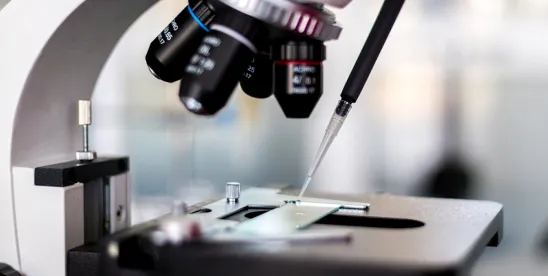Every single word matters. Nowhere was this truer than when the Federal Circuit recently held, in an appeal from the Patent Trial and Appeal Board captioned Pacific Biosciences of California, Inc. v. Personal Genomics Taiwan, Inc., that an apparatus for identifying a single biomolecule meant examining one biomolecule alone and not inferring its identity from an ensemble of copies. The court’s opinion provides a valuable lesson for patent practitioners as well as owners and potential challengers of patents.
Pacific Biosciences of California, Inc. — known as “PacBio” — filed two inter-partes reviews against U.S. Patent 7,767,441 B2 (“the ’441 patent”), which issued to Personal Genomics Taiwan, Inc. — referred to here as “PGT”. PacBio was successful in one (IPR2020-1163, “the ’1163 decision”), invalidating claims 1‐6, 9, and 43‐58 of the ’441 patent as anticipated by, or obvious over, a PCT publication known as “Choumane,” and unsuccessful in the other (IPR2020-1200, “the ’1200 decision”).
Both parties appealed. PacBio argued before the Federal Circuit that the claim preamble should not have been construed to mean single-molecule detection sensitivity, while PGT argued that single-molecule detection sensitivity was neither known nor rendered obvious by the prior art. The court affirmed both IPR decisions.
A typical patent claim has three parts: the preamble, a transitional phrase and the body reciting the elements of the invention. A “preamble generally is not limiting when the claim body describes a structurally complete invention such that deletion of the preamble phrase does not affect the structure or steps of the claimed invention.” MPEP 2111.02 & 2111.02(II). This is typical for apparatus claims which often recite sufficient structure in the body.
However, a preamble may be limiting, for example, when it is necessary to give “life, meaning and vitality” to the claim. A preamble may also be limiting when it recites the structure of a claimed invention. A preamble may further be limiting when it is used to distinguish the claimed invention from the prior art. And, as in the case at issue here, the preamble may be limiting when it provides antecedent basis for a limitation in the claim.
All independent claims (11, 12, 16, 30 and 43) of the ’441 patent either require the apparatus of claim 1 or have the same relevant preamble:
Claim 1. An apparatus for identifying a single biomolecule, comprising:
a substrate having a light detector; and a linker site formed over the light detector, the linker site being treated to affix the biomolecule to the linker site;
wherein the linker site is proximate to the light detector and is spaced apart from the light detector by a distance of less than or equal to 100 micrometers.
Neither PacBio nor PGT contested that the preamble provides antecedent basis for the biomolecule and is therefore a limiting feature. Neither party contested whether the preamble refers to a capability of the apparatus. Rather, the parties disputed whether the phrase in the preamble meant examining a biomolecule alone or examining copies and inferring its identity. This mattered because prior art reference US 2004/0197793 (“Hassibi”), relied upon in the ’1200 decision that PacBio lost, disclosed a bioluminescence regenerative cycle (BRC) assay. In a BRC assay, a nucleic acid sequence is identified after amplifying it.
Unless a term is specifically defined in the patent, its proper construction is determined by the ordinary meaning of the claim language understood in the context of the patent document. In this case, the ’441 patent did not explicitly define what was meant by identifying a single biomolecule. The court noted that ’441 patent describes an apparatus for identifying a single biomolecule using optical detection to monitor a large number of biomolecules in parallel. Figure 2 of the ’441 patent shows an optical detection apparatus that uses a light detector in close proximity (e.g., ≤ 100 µm) to a linker site that is treated to affix a biomolecule, 30, having a fluorophore, 36:

The ’441 patent background states that devices are needed that are capable of sequencing single molecules but avoid the problems associated with copying biomolecules. These problems included asynchrony in amplification, such as drift between the sequences of ideally clonal templates, as well as dephasing of the stepwise sequencing reactions used in clustered sequencing methods.
The Board found that “identifying a single molecule” referred to “running myriad optical detection apparatuses in parallel to detect a single or individual biomolecule in each such apparatus.”
PacBio argued that the Board conflated identifying a single molecule with detecting a single molecule. The court disagreed. It noted that “in some contexts, … a molecule can be identified by … making copies, examining the resulting ensemble, and inferring the identity of the starting molecule.” But the court said the facts in this case are different. The court said the ’441 patent identifies the problems overcome by single-molecule detection and this affects the preamble construction:
[T]he ’441 patent recognizes the problems with such processes and seeks to avoid those problems by claiming an apparatus capable of identification by single-molecule examination. Such a claim does not “conflat[e]” identification with detection but instead uses a detection requirement to specify a particular identification capability. Emphasis added.
The court said dependent claims “add capabilities to those stated in the independent claim …[and] underscore[s] what is not required by the claim 1 phrase itself,” such as claims 26 and 30 that recite, respectively, “nucleic acid is amplified” and “one or more”:
Claim 16. A method of sequencing a nucleic acid, comprising the steps of: affixing one nucleic acid molecule to the linker site of the apparatus of claim 1; and performing nucleic acid sequencing of the nucleic acid molecule on the apparatus.
Claim 26. The method of claim 16, wherein the nucleic acid is amplified at the linker site before nucleic acid sequencing.
Claim 30. A method of detecting a biomolecule, comprising the steps of: affixing one or more biomolecule [sic] to the linker site of the apparatus of claim 1; and detecting the biomolecule on the apparatus.
Claim 26 includes the limitations of claim 1 and clarifies that claim 1 embraces affixing one molecule before sequencing, in claim 16, or amplification, in claim 26. Claim 30 includes the limitations of claim 1 and recites “one or more,” which also clarifies that claim 1 embraces single-molecule detection since claim 30 recites one or more than one biomolecule.
The use of the word “single” before “biomolecule” mattered. The court concluded there was no other reason to include it but to exclude molecular ensembles:
The striking feature of the phrase is its inclusion of the word “single.” There is no apparent reason for the inclusion of the word “single” in the phrase except to indicate that the capability required is to identify a molecule with just that one molecule in view. Emphasis added.
Accordingly, the court found — consistent with the Board’s interpretation — that “identifying a single molecule” meant “(a) ascertaining the identity of a biomolecule, i.e., what that biomolecule is, and (b) doing so by examining just that one biomolecule, not others (even copies).”
The Federal Circuit thus affirmed the preamble claim construction that the Board had adopted in both the ’1200 and ’1163 decisions. The Board had found that the prior art, Choumane, disclosed an invention for the detection and observation of individual chromophores, which the Board reasonably understood to disclose the capacity to identify one individual biomolecule or single-molecule detection sensitivity. The Federal Circuit found that the Board had substantial evidence to arrive at these decisions and therefore affirmed their decision invalidating claims 1‐6, 9, and 43‐58 of the ’441 patent over Choumane.
Take-aways
Based on the construction that “identifying a single biomolecule” meant single-molecule detection sensitivity, the court affirmed both the ’1200 and ’1163 decisions. Every word matters. The ’441 patent described detecting single biomolecules affixed less than 100 µm from an optical detector. The specification taught this avoided the problems associated with copying. Dependent claims clarified single-molecule detection sensitivity was the intended claim scope. And, strikingly, the court found that there was no other reason to use the word “single” but to mean single-molecule detection sensitivity.
While this emphasizes that the specification is “the single best guide to the meaning of a disputed term,” it may behoove practitioners to define terms used in the claims, even in the preamble, to avoid these disputes.




 />i
/>i

